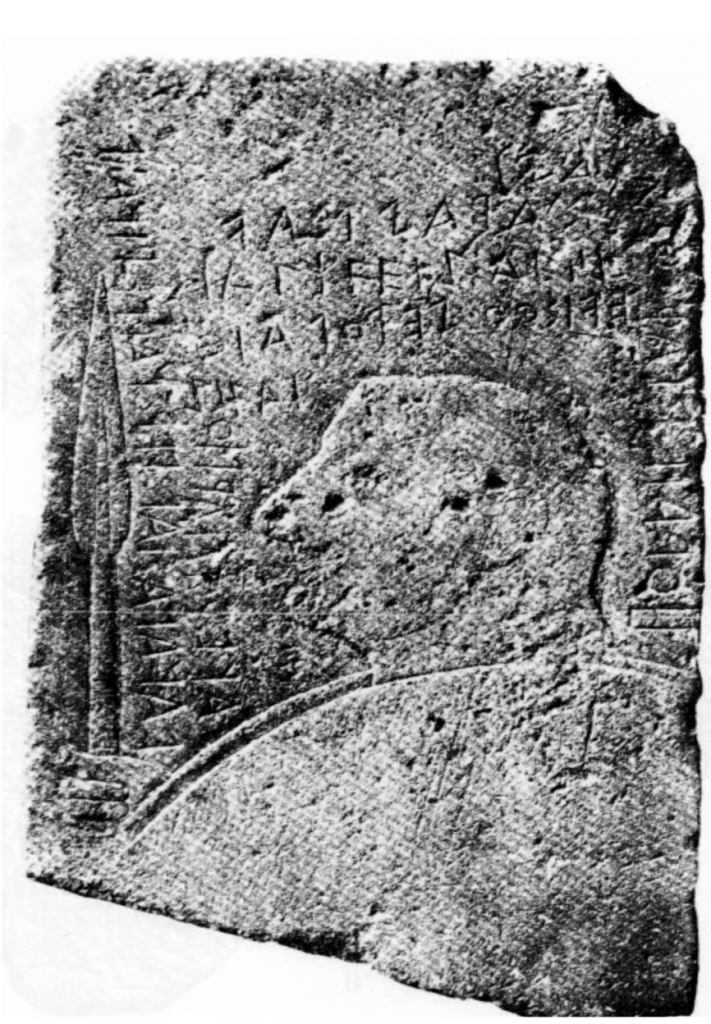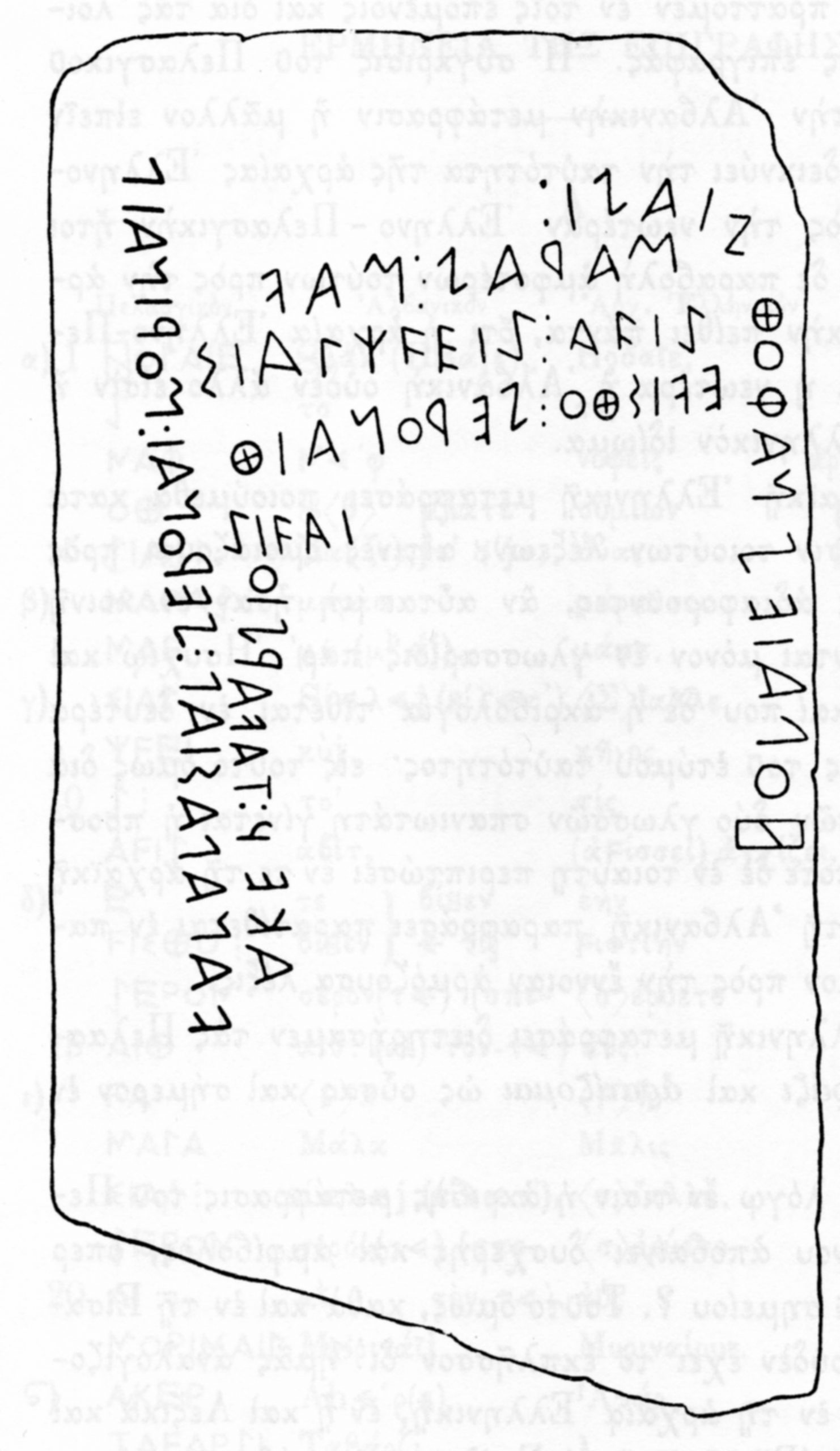HONOUR TO THE FIGHTER
Cholaios’ Sepulchral Stele
Praising a brave fighter killed in battle.
The inscription was found in 1886, by researchers of the French Archaeological School at the settlement of Kaminia, Lemnos, Greece.
It dates back to the 6th Century B.C..
This is the inscribed stone, as it is depicted in the book Pelasgika (Πελασγικά) written by Iakovos Thomopoulos.

What follows is the identification and clear writing of the text which is inscribed on the main aspect of the stone.

This is an accurate copy of the clear writing of the text of the stone, as it is found on page 6 of the book Pelasgika (Πελασγικά) written by Iakovos Thomopoulos.
In the text we can find a hymn on the Sepulchral Stele about the brave fighter killed in battle.
The text is a document of the honour to a heroically killed in battle fighter.
We studied the phonetic values in the actual text. We understood it, we read and rendered it into Modern Greek, but we also approached it philosophically.
Deecke, Pauli, Torp, G. Cousin, Nachmanson dealt with the inscription in the past, while the Greek Iakovos Thomopoulos, approached the inscription through the Arvanitic language (Arvanitika/ Αρβανίτικα). Ιt was written boustrophedon. Τhroughout the text one can find Ηomeric words, words of the Classical Literature as well as a lot of Pontic words, the majority of which are used nowadays in the Pontic Dialect, almost unchanged, and they can be fully understood by a competent speaker of the Pontic Dialect.
The text on the inscription is divided in two parts: The first one includes the fighter’s head in a semicircle, while the second one is written sidelong, on the right part of the Sepulchral Stele.
It is the oldest inscription that has been found and studied by the researchers.
The residents of the island of Lemnos, were probably Pelasgians, farmers and stock-breeders, who lived in the 6th century B.C., and who left a historic imprint through their rules and institutions.
Figuration of the phonetic values of the text.
The text belongs to the mixed texts of the Proto-Greek Script. This is the reason it includes phonograms of the Linear B Script.
This is a glossary about the explanation of some letters of the text, and that are necessary for writing it clearly.
- The Modern (X) matches to ().
- The Modern (Σ) matches to (και).
- The Modern (Σ) matches to (και).
- The Modern (Β) matches to (F), which is called “digamma”.
- The Modern (Θ) matches to ().
- The Modern (Κ) matches to ().
In our own view, the phonetic values are formed as follows:
ΧΟΛΑΙΕ ΤΣ ΝΑΦ ΟΘ ΤΣΙΑ ΤΣΙ : ΜΑΡ ΑΤΣ : ΜΑF ΣΙΑΛΚFΕΙΤΣ : ΑFΙΤΣ ΕFΙ ΣΘΟ : ΤΣΕΡΟΝΑΙΘ : FΑΝΑ ΛΑΣΙΑΛ : ΤΣΕΡΟΝ ΑΙ : ΜΟΡΙΝΑΙΛ : ΑΚΕΡ : ΤΑFΑΡΤΣΙΟ : ΤΣΙ FΑΙ
The language of the text is Greek, Archaic, typical of any Doric text. The grammatical structure of the text is mixed.
One can identify Pontic words, as well as Classical Greek Language.
The utterance of the words and of the verbal types, follows the grammatical rules of the Pontic Dialect, as well as those of the Classical Greek Language.
Rendition of the text:
Χολάιε τσί αναφέρ ότι: ατ®ειά τσί μάρ άτσ, μαβεί τ®ιαλκβέϊτσ.
Αβίτς εβεί σθο, τσέρον αήθης.
Βάνα λα®ιάλ τσέρον αεί Μορινάηλ.
Ακέρ ταβαρτ®ήν τσί βαεί.
The Τext in Modern Greek:
Cholaios, who says that: Who illuminates mad minds, even if he is insane?These people are cheered by an immoral slaughterer everywhere. I taunt the slaughterer forever, Morinail. Who praises a young fighter with songs?
(Χολάιε, ποιός αναφέρει πως: άραγε ποιός ευρισκόμενος σε έξαρση παραφροσύνης, έτσι φωτίζεισαλεμένους εγκεφάλους. Αυτούς ζητωκραυγάζει όπου στέκεται ο σφαγέας αήθης. Χλευάζω τονσφαγέα για πάντα Μορινάηλ. Ακερσεκόμη πολεμιστή ποιός υμνεί με τραγούδι).
This is the text on the aspect of the inscription.
Rendition of the text, the Τext in Pontic Dialect, the Τext in Modern Greek:
ΧΟΛΑΙΕ: Cholaios
ΤΣ: Who
ΝΑΦ: Says
ΟΘ: That
ΤΣΙΑ: Perhaps
ΤΣΙ : Who
ΜΑΡ: Insane
ΑΤΣ : In that way
ΜΑF: Illuminates
ΣΙΑΛΚFΕΙΤΣ : Mad minds
ΑFΙΤΣ: These people
ΕFΙ: Cheers
ΣΘΟ : Everywhere
ΤΣΕΡΟΝ: The slaughterer
ΑΙΘ : Immoral
FΑΝΑ: Put
ΛΑΣΙΑΛ : Taunt
ΤΣΕΡΟΝ: The slaughterer
ΑΙ : Forever
ΜΟΡΙΝΑΙΛ: Morinail
ΑΚΕΡ : Young
ΤΑFΑΡΤΣΙΟ : Fighter
ΤΣΙ :Who
FΑΙ: Praises with songs.
This is the text on the right sideways aspect of the inscription.

This is an accurate copy of the inscription as it is found on page 7 of the book Pelasgika (Πελασγικά) written by Iakovos Thomopoulos.
Figuration of the phonetic values of the text.
ΧΟΛΑΙΕ ΤΣΙ : ΦΟΚΙΑ ΣΙΑΛΕ : ΤΣΕΡΟΝ ΑΙΘ : ΕFΙ ΣΘΟ : ΤΟ FΕΡΟΝ Α ΡΟΜ : ΧΑΡΑΛΙΟ : ΤΣΙFΑΙ : ΕΠ ΤΕΤΣΙΟ : ΑΡΑΙ : ΤΙΤΣ : ΦΟΚΕ : ΤΣΙ FΑΙ : ΑFΙΤΣ : ΣΙΑΛΚFΙΤΣ : ΜΑΡ ΑΤΣ Μ : ΑFΙΤΣ ΑΟΜ ΑΙ
Rendition of the text:
Χολάιε τσί Φώκιαλης τ®ηαλεύ τσέρον αήθην. Εβίουν στώοι το βερόν. Αούτος ρωμαίος και χάραλης,Τσί βαεί επ’ τετ®ίο αραεί τίτ® Φωκαείς. Τσί βαεί αβίτς τ®ιαλκβέιτσ μάρ άτσ μα; Αβίτς α όμνυμι αεί.
The Τext in Modern Greek:
Cholaios, which Fokaeus appreciates an immoral slaughterer? They stayed in their hometown experiencing decay (death). He is strong and happy, who can chant hymns on a platform and curses people from Fokaia, the same way he curses iron bars? Who sings for those with mad minds and being insane, perhaps? I swear these for them forever.
(Χολάιε ποιός Φωκαεύς δίνει σημασία σε σφαγέα αήθη. Βίωναν μένοντας στον τόπο τους την φθορά(τον θάνατο). Αυτός είναι δυνατός και χαρούμενος, ποιός τραγουδάει ύμνους επάνω σε εξέδρα καικαταράται ως σίδερα τους Φωκαείς. Ποιός τραγουδάει για αυτούς με σαλεμένα κεφάλια σε έξαρσηπαραφροσύνης, έτσι ναί; Για αυτούς αυτά ορκίζομαι για πάντα).
Rendition of the text, the Τext in Pontic Dialect, the Τext in Modern Greek:
ΧΟΛΑΙΕ: Cholaios
ΤΣΙ : Which
ΦΟΚΙ: Fokaeus
ΣΙΑΛΕ : Appreciates
ΤΣΕΡΟΝ: Slaughterer
ΑΙΘ : Immoral
ΕFΙ:They were experiencing
ΣΘΟ : They stayed in their hometown
ΤΟ: the
FΕΡΟΝ: Decay
Α: He
ΡΟΜ : Strong
ΧΑΡΑΛΙΟ : and Happy
ΤΣΙ: Who
FΑΙ : Chants Hymns
ΕΠ: on
ΤΕΤΣΙΟ : a Platform
ΑΡΑΙ : He curses
ΤΙΤΣ : Like Dyed Iron Bars
ΦΟΚΕ : People from Fokaia
ΤΣΙ :Who
FΑΙ : Sings
ΑFΙΤΣ : for Those
ΣΙΑΛΚFΙΤΣ : with Mad Minds
ΜΑΡ: being insane
ΑΤΣ: Perhaps
Μ : Yes
ΑFΙΤΣ: For them
Α: These
ΟΜ:I swear
ΑΙ: forever
A Philosophical Approach:
Through the meaning of the words written on the Sepulchral Stele, we can understand that during this era, there was a colony of the people from Fokaia on Lemnos.
This town was attacked by the indigenous neighbors Sintians (pirates) of Lemnos. We understand that the author is a Fokaeus and praises his co-fighter, who was killed in battle, whose name was Cholaios (Χολάιος).
Ηe refers to one of his compatriots, who collaborated with the invaders as a traitor, and he characterizes him as the responsible for slaughter.
This person’s name is Morinail (Μορινάηλ).
He taunts him as an immoral person and as a slaughterer, while he names the invaders as mad minds, who were probably invited by him to invade the town.
Morinail was insane, and he praises the invaders, cursing the people from Fokaia, his compatriots, at the same time, calling them iron bars, which means they were hard.
The people who were the victims of this attack, defend themselves with courage. One of these victims, who was also killed in the battle, was Cholaios (Χολάιος).
The traitor is not a mature man, but an adolescent, who is probably in a hurry to feature himself.
While the town is controlled by the invaders, he sings for them, he maybe eccentrically praises them.
However, History recorded him.
The inscriber of the Sepulchral Stele, witnesses I swear these for them forever, they really happened this way.
He swears for the facts, so that people keep in mind that Morinail was a traitor across time.
Cholaios, the man killed in battle while fighting heroically, was honoured for his bravery.
The Sepulchral Stele honours his struggle across time.
This place has engulfed a lot of brave fighters, who were killed while struggling for their country.
However, the traitors are characterized as dark spots in History, because they wanted to illegally usurp power and wealth.
